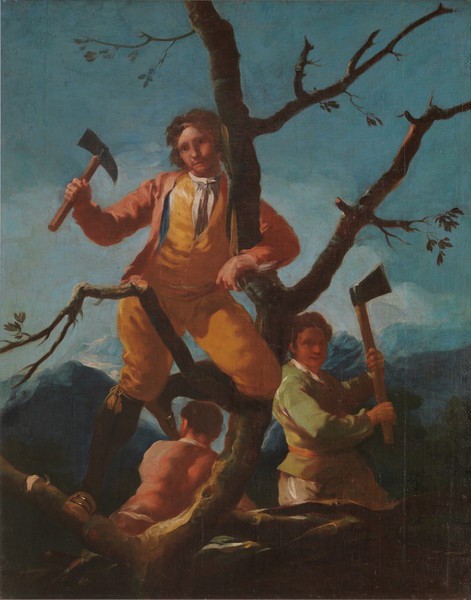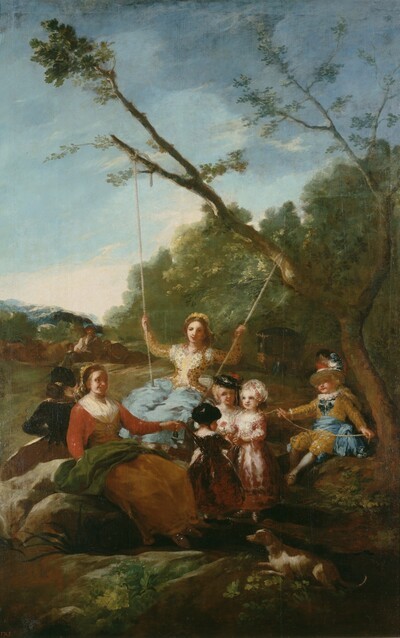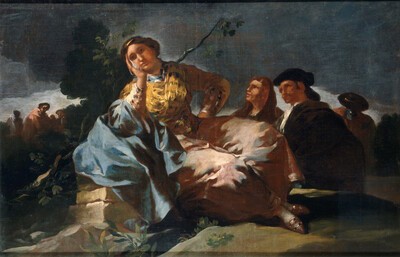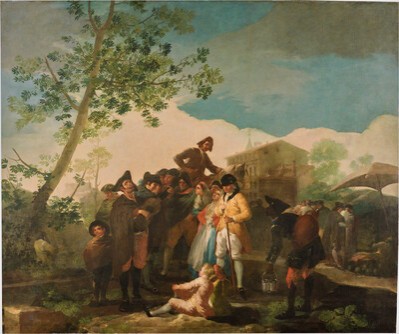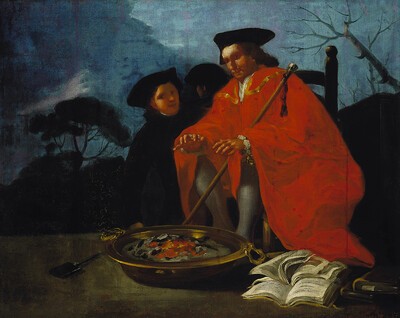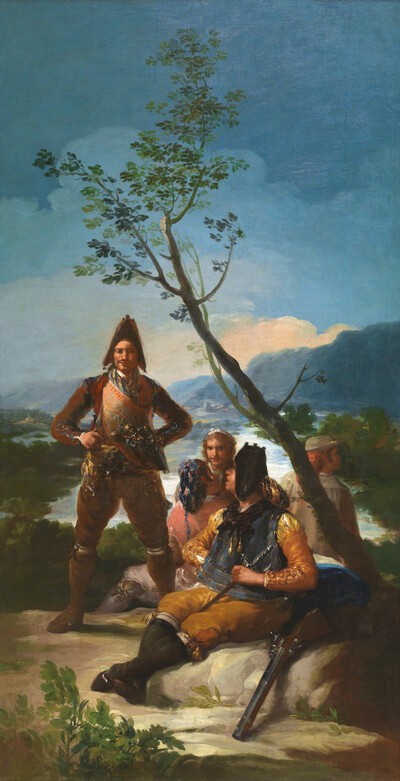- Cronología
- 1779 - 1780
- Ubicación
- The Prado National Museum. Madrid, Madrid, Spain
- Dimensiones
- 141 x 114 cm
- Técnica y soporte
- Oil on canvas
- Reconocimiento de la autoría de Goya
- Documented work
- Titular
- El Prado National Museum
- Ficha: realización/revisión
- 30 Nov 2009 / 14 Jun 2023
- Inventario
- (P00791)
See The Blind Guitarist.
This cartoon was delivered to the Royal Tapestry Factory on 24 January 1780, along with ten other cartoons, completing the decoration of the antechamber to the bedroom. These eleven tapestry cartoons - almost certain to have been made between 21 July 1779, when the artist delivered A Stickball Game and The Swing, and this delivery in January 1780 - were executed very rapidly. It is very likely that Goya was aware of the planned suspension of manufacturing work at the factory and was anxious to finish his commissions and receive his wages.
Around 1856 or 1857, the cartoon was moved from the Royal Tapestry Factory of Santa Bárbara to the Royal Palace in Madrid. In 1870, it was taken to the Prado Museum under orders given on 18 January and 9 February.
This overdoor piece decorated the north wall of the bedroom antechamber, where it formed a pair with another overdoor, Majo with Guitar.
José Manuel Arnaiz considers this cartoon to be a clear step backwards in the work of Goya. The use that the artist makes of the materials employed in the preparation of the canvas, incorporating them into the colour of the work, recalls the work of the first series of cartoons, in which the artist was yet to achieve the status of master painter. Only in the buckles of the shoes worn by main woodcutter can we see the Goya of his more recent, better works, says Arnaiz, and the influence of Antonio González Velázquez is very apparent. However, Camón Aznar is of the opinion that the compositional structure of The Woodcutters is magnificent, as are the earthy tones and the "glorious blue background" of the sky. Gudiol points out Goya's skill in depicting anonymous types.
Nordström relates this cartoon to melancholy and wintertime. Tomlinson goes further, comparing the woodcutters to a Cupid whose love goes unrequited, cutting off the dead wood from a tree that is just as sterile as his efforts to be loved.
-
GoyaPalacio de PedralbesBarcelona1977from April 12th to June 30th 1977cat. 9
-
Goya. 250 AniversarioMuseo Nacional del PradoMadrid1996consultant editor Juan J. Luna. From March 29th to June 2nd 1996cat. 31
-
Tapices y cartones de GoyaPalacio RealMadrid1996organized by Patrimonio Nacional and Sociedad Estatal Goya 96 at the Palacio Real, Madrid, consultant editor Concha Herrero Carretero. May to June 1996cat. 23
-
Tapices de GoyaMadridPatrimonio Nacional1946pp. 116, 241, cat. 36 y láms. 132-133
-
L'œuvre peint de Goya. 4 volsParís1928-1950vol. I, p. 86, cat. 27
-
Goya, Saturno y melancolía. Consideraciones sobre el arte de GoyaStockholmAlquimis & Wiksell1962p. 37
-
Vie et ouvre de Francisco de GoyaParísOffice du livre1970pp. 76, 89, cat. 139
-
BarcelonaPolígrafa1970vol. I, p. 249, cat. 95
-
L’opera pittorica completa di GoyaMilanRizzoli1974pp. 95-96, cat. 97
-
Francisco de Goya, 4 vols.ZaragozaCaja de Ahorros de Zaragoza, Aragón y Rioja1980-1982vol. I, p. 114 y vol. II, p. 32 (il.)
-
Francisco de Goya, cartones y tapicescol. col. "Espasa Arte"Espasa Calpe1987pp. 108-109, 281, cat. 40C y p. 109 (il.
-
Francisco de Goya. Los cartones para tapices y los comienzos de su carrera en la corte de Madridcol. col. "Ensayos de Arte Cátedra"MadridCátedra1987pp. 153, 156, 157 y p. 154 (il.)
-
Goya. 250 AniversarioMadridMuseo del Prado1996pp. 310-311, cat. 31 y p. 106 (il.)
-
Salas del Palacio Real de El Pardo para las que se tejieron tapices sobre cartones de Francisco de Goya: identificación de las habitaciones y ajuste de las obras de Goya en los alzados de las paredesin HERRERO CARRETERO, Concha (curator, Tapices y cartones de Goya (catalogue of the exhibition organizated at the Palacio Real de Madrid, from may to june 1996)MadridPatrimonio Nacional, Goya 96, Lunwerg1996p. 169 (il.)
